In a world where the most talked about 60 seconds of the Super Bowl involved a $7M black screen emblazoned with nothing more than a bouncing, polychrome QR code, the road between market leader and straggler is paved with white noise.
A more compelling product or better pricing aren’t particularly helpful if your ideal customers don’t even know they exist. In order to be considered, you need to stand out.
By analyzing how your competitors talk about themselves, you equip yourself with the information needed to craft powerful, unique messaging of your own. Now, conducting a full-scale competitive analysis can feel daunting, particularly when your sole focus is on verbiage.
Enter competitor messaging analysis, the art of dissecting what the other players in your space say about themselves in the name of differentiation and, ultimately, market domination.
Here, we will focus specifically on gathering and leveraging competitor messaging before discussing how to present this data with org-wide accessibility in mind.
Step 1: Familiarize yourself with your competitors’ messaging
Before you can start analyzing your competitors’ messaging, you need to collect it. This might sound like a daunting task, but it’s actually pretty straightforward. Unlike, say, pricing models or tertiary product features, messaging is incredibly easy to find. It’s ingrained into every piece of content since, you know, it’s used to attract prospects.
As you run through this process of intel gathering, take rough notes. Screenshot everything. We’ll worry about organization once we’ve got what we need.
With that, let's put our customer hats on and start panning for gold.
Homepage
At the risk of being reductively obvious, there is no place like home.
A homepage is a brand’s first impression. Sure, a prospect might be led to the site from a social post or email or, if you’re Coinbase or a restaurant in 2022, a QR code. But a homepage will no doubt convey the purest distillation of messaging.
Scroll. Look at how the page is structured. Do they prioritize new features or do they play the hits? Does it read like a text message or a textbook? Is it the brand’s voice that rings throughout or the customers’?
Here's the hero section of Mailchimp’s homepage:
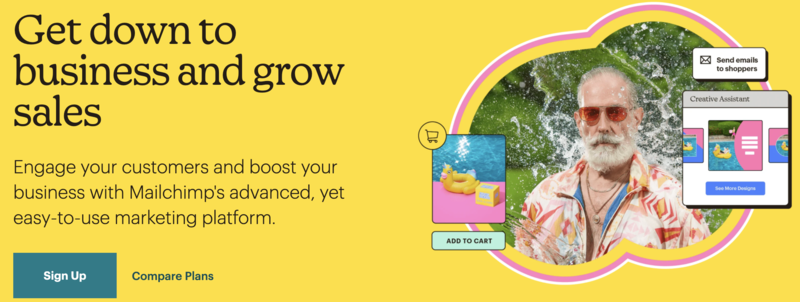
Grow sales. Boost your business. Easy-to-use.
Thematically, the focus is on SMB growth fueled by a powerful, simple tool, a theme echoed down the page through customer profiles and feature deep-dives.
Once you’ve combed through the headlines and body copy for key messaging, go one layer deeper. Inspect the page and command+f title and alt tags. This will help you uncover the messaging written for algorithms, not customers. It’s less sexy, but every little detail aids in discovery.
Product pages
Product pages are where the most technical language about your competitors collides with marketing copy to create a treasure trove for the sleuthing PMM.
You expect them to be feature-rich, outlining what a product does and the problems it solves. But today we care about how that information is articulated. Take HubSpot, for example. They have product pages for their marketing, sales, service, CMS, and ops tools. We’re going to focus on the messaging used on one of them: the sales software page.
Unlike most product pages, the hero is not overwhelmingly loud. In fact, it’s a UX designer’s rendering of the product next to a nested menu full of dry, important information (product description, pricing, a bulleted list of features).
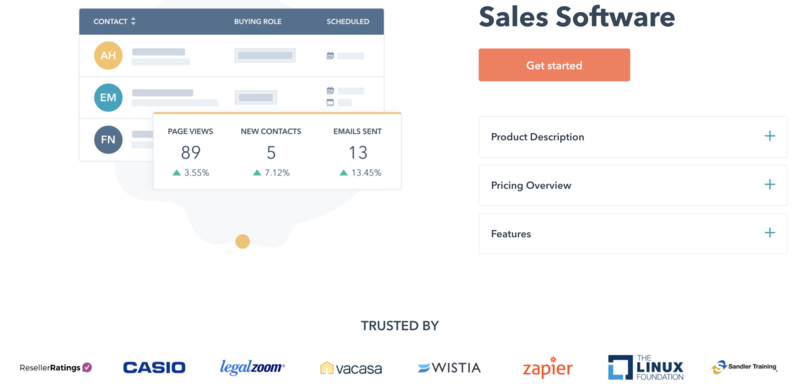
The blaze of logos, however, is not presented without context; the customers are preceded by a brief but powerful “trusted by.”
Next, we get into the most important messaging on the page:
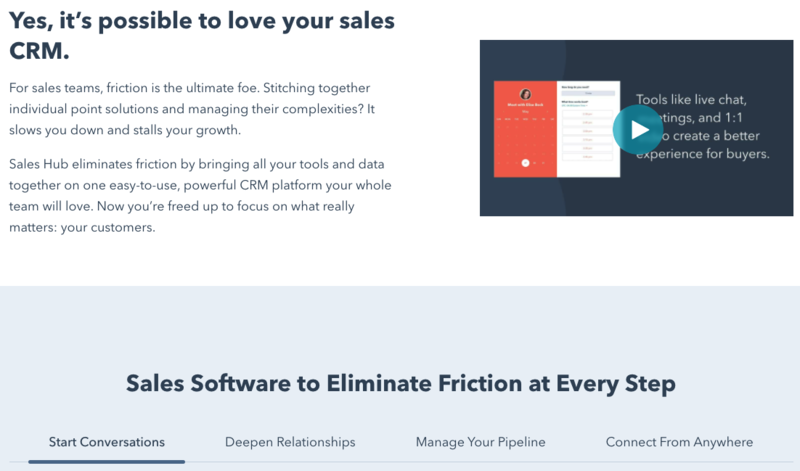
It’s possible to love your sales CRM.
How?
Well, based on the number of times the word “friction” appears (repetition is your friend!), it’s a love born of convenience; HubSpot helps you “start conversations” and “deepen relationships” and “connect.” Reads more like a product page for Hinge than a CRM, right? And that’s very much by design. It creates a lens through which a prospect reads the standard set of features, CTAs, testimonials, and FAQs that follow.
I don’t mean to minimize their importance either: all are important to analyze for keywords. Pay particular attention to how verbs are used: Who is “doing the doing”—the tool or the customer?
Press releases—more specifically, the boilerplate
Allow me to introduce you to your new best friend: the boilerplate, or the highly-manicured paragraph(ish) tacked onto the end of any newsworthy announcement. Take ours for example:
Crayon is the competitive intelligence backbone that enables mid-market and enterprise businesses to see and seize opportunities and create sustainable advantages in their markets. Hundreds of organizations use Crayon to capture sharp insights that can be easily accessed and acted on to drive broad, measurable, and meaningful impact.
This is a pure, fluffless distillation of what Crayon is and how we talk about ourselves. It touches on who we work with (mid-market and enterprise businesses) and how we help them (see and seize opportunities to create sustainable competitive advantages) and what the result is (broad, measurable, and meaningful impact). If we were going to pivot the business (we aren’t!), it would be reflected here.
Even slight changes to a boilerplate can be meaningful to note because so much attention is given to articulating the company’s purpose and products in a concise manner.
Please, please, please—don’t sleep on the boilerplate.
Collateral
If your competitors are doing a good job of using consistent messaging, you’re likely to see a fair bit of overlap across web and printed content. Anybody can scoop up a one-pager at a booth and dissect it, or search for company PDFs using a tool like SlideShare.
But by collateral, I mean something infinitely more valuable than glossy cardstock pushing a demo: I mean the demo deck itself.
Easy to acquire? Nope. Worth the effort? Without a doubt. Sales presentations are the slightly aggressive, narrative-driven cousins of home and product pages. They press on pain points. They offer pricing promos that aren’t advertised on the website. They tout beta features months from public launch. If competitive messaging analysis is panning for gold, getting your hands on a competitor’s sales pitch is stumbling into a goldmine.
Emails
Finally, we have marketing emails—the only competitor messaging that will find you.
Sales and marketing emails, if you can get copies of them, can provide a more informal version of the company’s messaging. You may even start to see variations of messaging being tested by different individuals, and get hints of where the messaging may be going. My favorite application of email-driven competitor messaging analysis, however, is product-focused. Take a look at how Webflow uses email to announce a new feature, Workspaces:
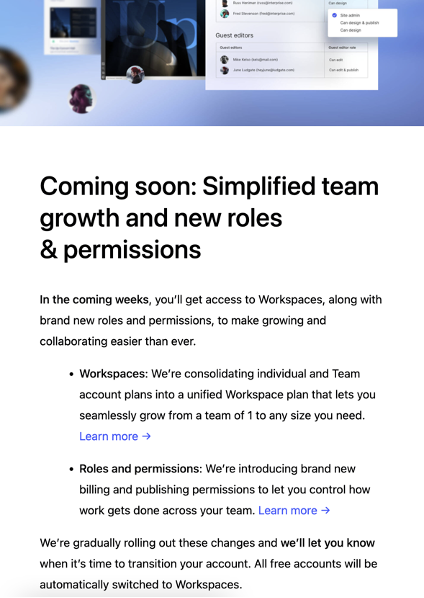
Simplified team growth. Seamlessly grow from a team of 1 to any size you need. Control how work gets done across your team.
A word to the wise: If your org uses all Google everything, create an inbox rule to route competitor emails into their own folder; this makes it easy to find and, more importantly, share.
Step 2. Compare their messaging to yours
You’ve gathered the data, now what?
Time to analyze.
Now, doing so without a framework is a fool’s errand, which is why we recommend taking everything you’ve learned about your competitors’ messaging and plugging it into a messaging hierarchy. This is a tiered system purpose-built to help you distill a brand down to its essence:
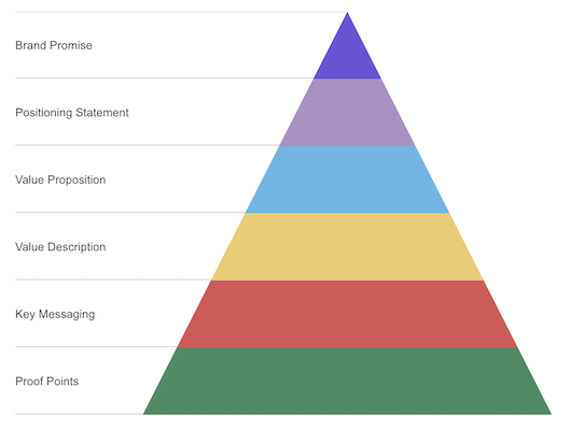
When we’ve talked about the use of a messaging hierarchy in the past, it’s been in the context of your own messaging. Today, we’ll turn the tool towards your competitors.
Here’s a brief overview of the components that make up a messaging hierarchy.
Proof points
The undeniable, immutable truths of your competitors’ products and services. Are they actually the cheapest? Did they win an award for excellence in the field? Have they saved over a million lives with best-in-class safety features?
These are facts, typically cited in headlines and graphics designed to catch prospects’ eyes.
Key messaging
A rollup of proof points.
While your menagerie of competitive messaging proof points likely exist as bullets, the key messaging should begin to distill those bullets into short, descriptive phrases that speak to their product’s value in clear terms.
- Proof point: Makes [process] easier.
- Key message: Allows customers to complete [process] in 5 minutes or less.
Value proposition
Take the most essential elements of your competitors’ key messaging statements, and leverage them to craft clear statements that define their products’ value. Look for the terms and concepts that are repeated often. (Remember that HubSpot page? Eliminate friction → build relationships).
Positioning statement
The positioning statement is about differentiation.
While a competitor’s value proposition may cite a number of benefits, their positioning statement should zero in on the precise ways those benefits separate their product from the rest of the field. From a CI utility standpoint, this is the most important component of the messaging hierarchy; it’s the piece of your efforts that account execs and marketers must a) understand and b) know how to counter.
Brand promise
The brand promise is simple and memorable. It distills all of the earlier stages of the messaging hierarchy into a single statement. It is the most refined of all stages, because it describes the experience customers should expect to have every time they interact with a brand. Often this promise can be found in a tagline.
Think different. Just Do It. Crunchitize me, Cap’n.
You get it, right?
The positioning statement and brand promise are, unequivocally, the two most important stages to consider when analyzing your competitors’ messaging, but a 360 degree understanding of their “big picture”—from proof points, to key messaging, to value proposition—is essential in formulating your own, winning messaging.
Step 3. Create a resource for your fellow marketers
You’ve done everything short of counting syllables and line breaks. You’ve organized it effectively. Let’s ensure org-wide accessibility.
Conducting this insanely valuable exercise in a vacuum is great for your own education. But in order to affect actual change in the competitive landscape, your entire team needs easy access.
Take the messaging hierarchies you’ve built for each of your competitors and push them into a spreadsheet (or some other document) where members of your organization can see each competitor's messaging analysis side-by-side. Something like this:
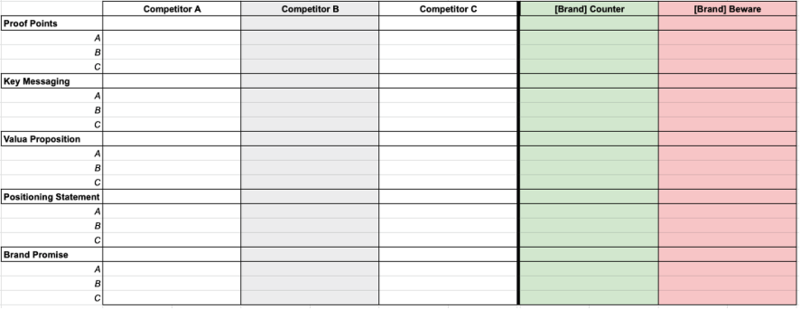
And now for the fun part. Create two columns outside of your competitor messaging hierarchy. What silver bullets can you share with your team? Where should they tread lightly when talking to or creating for prospects?
A living document
Messaging isn't static. Just as you are analyzing and adjusting your own, so are your competitors. It is critical to monitor changes to a company’s messaging across each of the sources mentioned. Once you have your competitive messaging matrix with each of the elements discussed, it is that much easier to make sense of a seemingly small change to a product page headline.
By analyzing your competitors’ messaging, you’ll be better equipped to craft your own differentiated messaging. Be sure to incorporate all the sources of your competitors’ messaging into your analysis and monitor shifts over time to adjust your own strategy as needed.

Related Blog Posts
Popular Posts
-
 How to Create a Competitive Matrix (Step-by-Step Guide With Examples + Free Templates)
How to Create a Competitive Matrix (Step-by-Step Guide With Examples + Free Templates)
-
 The 8 Free Market Research Tools and Resources You Need to Know
The 8 Free Market Research Tools and Resources You Need to Know
-
 Sales Battlecards 101: How to Help Your Sellers Leave the Competition In the Dust
Sales Battlecards 101: How to Help Your Sellers Leave the Competition In the Dust
-
 6 Competitive Advantage Examples From the Real World
6 Competitive Advantage Examples From the Real World
-
 How to Measure Product Launch Success: 12 KPIs You Should Be Tracking
How to Measure Product Launch Success: 12 KPIs You Should Be Tracking





